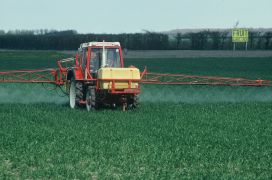| Both sides previous revisionPrevious revisionNext revision | Previous revisionLast revisionBoth sides next revision |
| capri:concept:spatialdownscaling [2023/06/02 09:42] – [Agricultural land use and environmental indicators at 1x1 km grid resolution- derived by spatial downscaling of economic model results] gocht | capri:concept:spatialdownscaling [2023/06/02 09:49] – [Methodology] gocht |
|---|
| |
| * **Some basic climate and soil parameters, slope and elevation**, as major explanatory variables used in the downscaling process | * **Some basic climate and soil parameters, slope and elevation**, as major explanatory variables used in the downscaling process |
| * **Selected [[:dokuwiki:doku|economic performance indicators]]:** revenues, variable production costs, gross margins; all expressed per ha of utilisable agricultural land | * **Selected [[:dokuwiki:doku|economic performance indicators]]FIXME:** revenues, variable production costs, gross margins; all expressed per ha of utilisable agricultural land |
| * **Estimates from a [[:capri:concept:DNDCMeta|statistical meta-model of the bio-physical model DNDC]]** as nitrous oxid emission, nitrate leaching or water transpiration by crops | * **Estimates from a [[:capri:concept:DNDCMeta|statistical meta-model of the bio-physical model DNDC]]** as nitrous oxid emission, nitrate leaching or water transpiration by crops |
| |
| |
| |
| The basic methodology for spatial down-scaling had been jointly developped by the Joint Research Centre and the Institute for Institute for Food and Resource Economics, University of Bonn, to a large extent in the context of the [[http://www.ilr1.uni-bonn.de/agpo/rsrch/dynaspat/dynaspat_e.htm|CAPRI-Dynaspat project]]. The team from JRC comprised members of the AgriEnv action, as well as of the Climate Change Unit. The down-scaled data are produced by statistical estimators for [[:capri:concept:SpatCrops|cropping shares,]] [[:capri:concept:SpatYields|crop yields]], [[:capri:concept:StockDens|animal stocking densities]], and [[:capri:concept:spatFert|fertilizer application rates]], starting from the regional data base of CAPRI. The data presented online cover a three year average 2001-2003, but data set had also been projected to 2013 and estimated for counter-factual policy scenarios. | The basic methodology for spatial down-scaling had been jointly developped by the Joint Research Centre and the Institute for Institute for Food and Resource Economics, University of Bonn, to a large extent in the context of the CAPRI-Dynaspat project. The team from JRC comprised members of the AgriEnv action, as well as of the Climate Change Unit. The down-scaled data are produced by statistical estimators for [[:capri:concept:SpatCrops|cropping shares,]] [[:capri:concept:SpatYields|crop yields]], [[:capri:concept:StockDens|animal stocking densities]], and [[:capri:concept:spatFert|fertilizer application rates]], starting from the regional data base of CAPRI. The data presented online cover a three year average 2001-2003, but data set had also been projected to 2013 and estimated for counter-factual policy scenarios. |
| |
| The data and methodology allows the //AgriEnv// action at JRC-IES to perform environmental impact assessment of the Common Agricultural Policy, both ex-ante as in a forward looking exercises. //Agri-Env// has in 2007 used the methodology to forecast the probable development of gross nitrogen balances and the share of High Nature Value farmland in the EU up to 2013, in close co-operation with DG-AGRI and the [[http://www.jrc.es/activities/agriculture/sustag.cfm|SUSTAG]] action of IPTS/Sevilla. For 2008, an analysis of impacts of increased bio-fuel production in the EU is planned by down-scaling and analysing results of CAPRI bio-fuel scenarios. Parts of the down-scaled data set are used in large-scale European research projects as [[http://www.seamless-ip.org/|SEAMLESS]] and [[http://www.lucsus.lu.se/html/sensor.aspx|SENSOR]]. | The data and methodology allows the //AgriEnv// action at JRC-IES to perform environmental impact assessment of the Common Agricultural Policy, both ex-ante as in a forward looking exercises. //Agri-Env// has in 2007 used the methodology to forecast the probable development of gross nitrogen balances and the share of High Nature Value farmland in the EU up to 2013, in close co-operation with DG-AGRI and the [[http://www.jrc.es/activities/agriculture/sustag.cfm|SUSTAG]] action of IPTS/Sevilla. For 2008, an analysis of impacts of increased bio-fuel production in the EU is planned by down-scaling and analysing results of CAPRI bio-fuel scenarios. Parts of the down-scaled data set are used in large-scale European research projects as [[http://www.seamless-ip.org/|SEAMLESS]] and [[http://www.lucsus.lu.se/html/sensor.aspx|SENSOR]]. |
| |
| ---- | ---- |


